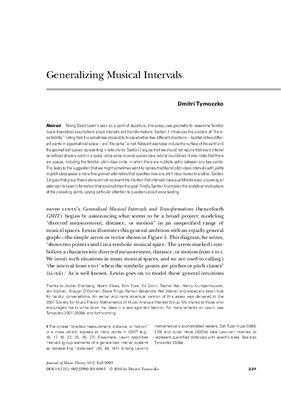Joual of Music Theory Fall 2009 53(2): 227-254
Abstract Taking David Lewin’s work as a point of departure, this essay uses geometry to reexamine familiar
music-theoretical assumptions about intervals and transformations. Section 1 introduces the problem of transportability, noting that it is sometimes impossible to say whether two different directions—located at two different points in a geometrical space—are the same or not. Relevant examples include the surface of the earth and
the geometrical spaces representing n-note chords. Section 2 argues that we should not require that every interval
be defined at every point in a space, since some musical spaces have natural boundaries. It also notes that there
are spaces, including the familiar pitch-class circle, in which there are multiple paths between any two points.
This leads to the suggestion that we might sometimes want to replace traditional pitch-class intervals with paths
in pitch-class space, a more fine-grained alteative that specifies how one pitch class moves to another. Section
3 argues that group theory alone cannot represent the intuition that intervals have quantifiable sizes, proposing an
extension to Lewin’s formalism that accomplishes this goal. Finally, Section 4 considers the analytical implications
of the preceding points, paying particular attention to questions about voice leading.
Abstract Taking David Lewin’s work as a point of departure, this essay uses geometry to reexamine familiar
music-theoretical assumptions about intervals and transformations. Section 1 introduces the problem of transportability, noting that it is sometimes impossible to say whether two different directions—located at two different points in a geometrical space—are the same or not. Relevant examples include the surface of the earth and
the geometrical spaces representing n-note chords. Section 2 argues that we should not require that every interval
be defined at every point in a space, since some musical spaces have natural boundaries. It also notes that there
are spaces, including the familiar pitch-class circle, in which there are multiple paths between any two points.
This leads to the suggestion that we might sometimes want to replace traditional pitch-class intervals with paths
in pitch-class space, a more fine-grained alteative that specifies how one pitch class moves to another. Section
3 argues that group theory alone cannot represent the intuition that intervals have quantifiable sizes, proposing an
extension to Lewin’s formalism that accomplishes this goal. Finally, Section 4 considers the analytical implications
of the preceding points, paying particular attention to questions about voice leading.

